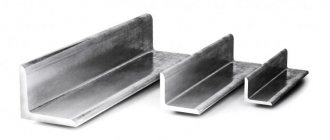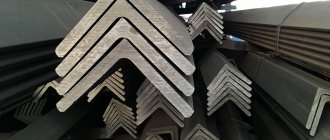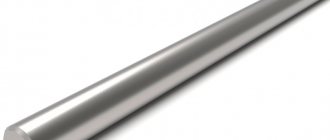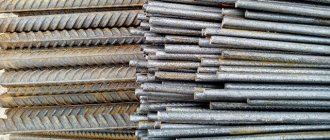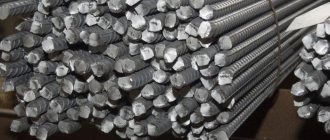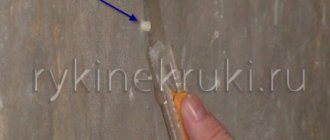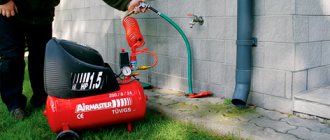The weight of the reinforcement must be known in order to calculate the required amount of material for reinforcing reinforced concrete structures. Knowing the required footage, using a table of values for the mass of reinforcing bars, you can convert meters into kilograms and calculate the required number of rods for purchase.
Why and how to determine the weight of reinforcement
Most private developers wondered how much 12 mm reinforcement weighs per meter - it is what is most often used for pouring foundations, monolithic basement walls, and armored belts. The answer to this helps solve at least two problems.
- Determination of the carrying capacity of the vehicle required to deliver materials to the construction site.
Not all developers use delivery services, and not all small sellers provide such a service. If you don’t need so many rods, it’s cheaper to pick them up yourself, but you need to know whether the load will be excessive for the car. Since the standard length of the reinforcement is 6 or 12 meters, many people cut it in half right on the spot and transport it on a trunk or in a trailer. Or they select short rods from unmeasured lots.
The number of short rods in unmeasured batches can reach 7% Source prom.st
See also: Catalog of companies that specialize in the design and installation of metal structures (canopies, greenhouses, etc.)
- Determination of reinforcement footage in ton.
Large volumes of rolled metal are sold using not meters or pieces as a unit of measurement for calculations, but a ton. If you know how many linear meters of reinforcing bars are contained in one ton, it will not be difficult to calculate the weight required for ordering and purchasing.
In theory, knowing the diameter of the required products and the density of the steel alloy from which they are made, you can independently calculate their weight. But in practice, such calculations will have a large error, since the reinforcement bars do not have a constant cross-section, but a periodic one, with longitudinal and transverse stiffeners. And they have two diameters - minimum and maximum.
Reinforcement cross-section - drawing Source ugmk.com
But there is no need to do this. A table compiled on the basis of GOST 5781-82 will help you find out how much the reinforcement weighs. This document regulates all parameters of these metal products. Their mass depends primarily on their diameter.
- The thinnest rods have a diameter of 6 mm and the weight of one linear meter is slightly more than 220 grams.
- The thickest 80 mm reinforcement is much heavier - more than 39 kg per linear meter.
The larger the diameter and denser the reinforcement pattern, the more important it is to know how much a meter of reinforcement weighs. The mass of the metal frame must be taken into account when calculating the load on the base, and an error can lead to unpredictable consequences.
GOST fittings
Reinforcement is used for the construction of critical structures, so the rods must meet all established quality requirements. The production of steel reinforcement is strictly regulated by state standards:
- GOST 5781-82 – applies to reinforcing hot-rolled smooth and corrugated round steel.
- GOST 12004-81 – describes the testing methods used for reinforcing steel.
- GOST R 52544-2006 – regulates the production of fittings of classes A500C and B500C.
- GOST 34028-2016 – applies to smooth and corrugated reinforcement of various classes.
Weight table
In accordance with the current standard, reinforcement of classes A240, A400 and A500C is used in construction. All weight values in 1 linear meter, in a rod 11.75 m long and in 1 ton of timber are summarized in the table. The error is acceptable, but insignificant, no more than a few percent.
Summary table for all diameters Source vezetnerud.ru
What does the mass of reinforcement depend on?
The main indicator that influences how much 1 linear meter of steel reinforcement weighs is the diameter. The larger it is, the correspondingly greater the mass.
With a reinforcement diameter of 6 to 80 mm, the weight of 1 meter ranges from 222 to 3960 grams.
As you can see, the difference is huge. Therefore, knowledge of the specific gravity of the reinforcement will not be superfluous when calculating the pressure of a structure on the foundation - several unaccounted tons of load can have a detrimental effect on the reliability and durability of any building.
Examples of calculations
To find out how much 1 meter of 12 mm reinforcement weighs, just find this diameter in the first column. The following gives the mass of 1 l.m. – 888 grams. And there are only 1126 meters in a ton, or, if you divide this value by the length of the rod, almost 96 pieces.
The design documentation may only indicate the diameter and weight of the reinforcement without indicating the footage. When purchasing individually, you will have to calculate how many pieces you need. For example, you need to buy 1.5 tons of 16 mm reinforcement to install a strip foundation.
- We find from the table how much 1 meter of reinforcement weighs - it is 1.58 kg.
- We convert 1.5 tons into kilograms, multiplying by 1000 - 1500 kg.
- Divide 1500 by 1.58 and we have 950 m.
- Or divide 1500 by 18.56 (the weight of one bar) and get 81 pieces.
These simple calculations will allow you not only to avoid making mistakes when purchasing, but also to check the amount of material delivered to the site.
When you need to find out how much a certain number of rods will weigh, do the opposite: multiply the weight of the rods of the required diameter by their number or footage. For example, you need to buy 30 rods, the thickness of the reinforcement is 20 mm. With a mass of one rod of 29 kg, the total weight will be 30 x 29 = 870 kg.
Table of weight of reinforcement by diameter
All data indicated in this table of reinforcement weights corresponds to GOST 5781-82. The error can be a maximum of several percent for reinforcement classes A1 (A240), A3 (A400) and A500C.
| Diameter of fittings, mm | Weight of 1 meter, kg | Rod weight 11.7 m, kg | Linear meters per ton |
| 6 | 0,222 | 2,5974 | 4504,5 |
| 8 | 0,395 | 4,6215 | 2531,65 |
| 10 | 0,617 | 7,2189 | 1620,75 |
| 12 | 0,888 | 10,3896 | 1126,13 |
| 14 | 1,21 | 14,157 | 826,45 |
| 16 | 1,58 | 18,486 | 632,91 |
| 18 | 2 | 23,4 | 500 |
| 20 | 2,47 | 28,899 | 404,86 |
| 22 | 2,98 | 34,866 | 335,57 |
| 25 | 3,85 | 45,045 | 259,74 |
| 28 | 4,83 | 56,511 | 207,04 |
| 32 | 6,31 | 73,827 | 158,48 |
| 36 | 7,99 | 93,483 | 125,16 |
| 40 | 9,87 | 115,479 | 101,32 |
| 45 | 12,48 | 146,016 | 80,13 |
| 50 | 15,41 | 180,297 | 64,89 |
| 55 | 18,65 | 218,205 | 53,62 |
| 60 | 22,19 | 259,623 | 45,07 |
| 70 | 30,21 | 353,457 | 33,1 |
| 80 | 39,46 | 461,682 | 25,34 |
Having the table at hand, you can quickly find out the specific gravity of 1 meter of reinforcement according to GOST, for example, with a diameter of 32 mm. Find the corresponding size in the first column and to the right of it is its theoretical mass, it is 6.32 kg, and a ton includes 158.48 meters.
Weight of composite reinforcement
Nowadays, fiberglass reinforcement bars are increasingly being used instead of steel reinforcing bars. They have a lot of advantages, including light weight. In addition, fiberglass has better tensile strength than steel, which allows the use of products with a smaller diameter. For example, an 8 mm composite rod is equivalent in its physical and mechanical characteristics to a 12 mm steel rod. Accordingly, the load decreases even more noticeably.
Table for determining the equivalent diameters of steel and composite reinforcement Source luxkompozit.ru
Compare how much a meter of 12 mm steel alloy reinforcement weighs (890 g) and a meter of fiberglass rod with a diameter of 8 mm (110 g). The difference is 8 times.
Types of fittings
There are various classifications of fittings that help you choose the most suitable product. According to their purpose, rods are divided into:
- working;
- constructive;
- installation room;
- anchor
Depending on the orientation, the reinforcement is divided into:
- transverse – protects concrete from oblique damage;
- longitudinal - takes on tensile and compressive loads.
Depending on the mechanical characteristics, there are several types of fittings:
- A-I (A240). Manufactured by hot rolling from steel grades St3kp, St3ps, St3sp. Supplied in rods and coils and has a smooth surface.
- AIII (A400). It has a corrugated surface with uniform transverse protrusions. In the post-Soviet space, this type was the most common for the production of reinforced concrete and monolithic products. It was also used to strengthen road surfaces. It provides powerful adhesion to concrete and gives the necessary strength to the entire structure. Such fittings are made from 35gs steel, which is characterized by high strength and good weldability. AIII (A400) reinforcement made of 25G2S steel, which has improved characteristics, is also common. The ends of the rods of such products are painted white.
- A500C. It consists of hot-rolled rods, the strength of which is increased by thermomechanical means. Such fittings began to be produced in 1993 and, due to their advantages, have become widespread. It is made from cheaper raw materials, which reduces the cost of the final product. At the same time, the rods are more durable and flexible. Due to the improved weldability of the metal, arc welding can be used.
- At800. It is produced by hot rolling, after which it is strengthened by thermomechanical method. The surface can be either smooth or corrugated. Such reinforcement is characterized by high strength, ductility and is resistant to environmental influences.
Briefly about the main thing
When starting construction and ordering materials for it, it is important to be able to calculate them correctly and control delivery, without allowing suppliers to deceive you. To do this, you need to know how many kilograms of cement are in a bag, how many boards are in a cubic meter, how many kg are in 1 meter of reinforcement with a diameter of 12 mm. Such knowledge can be very helpful in calculating loads on building structures and in solving transportation issues. In the case of fittings, everything is simple - you just need to look at the table and find the necessary data in it.
Ratings 0
REINFORCEMENT DENSITY
12.04.2019
|In Armature
|By SEO
Long products
- Rebar, wire rod
- Beam, channel
- Corner
- Circle
- Stripe, square
Sheet metal
- Hot-smoked sheet
- Cotton sheet
- Galvanized sheet
- Corrugated sheet
- Expanded metal sheet (PVL)
- Stainless steel sheet
Pipes
- Pipes h/d
- Cold pipes
- VGP, electric welded pipes
- Stainless steel pipes
- Pipeline accessories
Stainless steel
- Circle, square, hexagon
- Strip, corner
- Stainless steel pipes
- Stainless steel sheet
- Stainless steel hardware
- Accessories for stair railings
- Pipeline details
Hardware and metal raw materials
- Calibration, silver
- Wire, ropes
- Mesh, tape
- Radiators, electrodes
Non-ferrous metals
- Aluminium, duralumin
- Copper, bronze, brass
- Tin
- Lead
- Zinc
All the necessary data, taking into account the class of steel and the diameter of the rods, is given in the calculation tables. The calculation process itself (when drawing up a construction plan, taking into account the construction of the reinforcing mesh) includes the following steps: select the appropriate diameter of the rods, calculate the footage of the required reinforcement, multiply the weight of one meter of reinforcement of the corresponding diameter by the number of required rods. We'll get a full 4 kilograms. The cross section of a cylinder is a circle. GOST R 52544-2006 are profiles of classes A500C and B500C made of periodic steel, intended for welding.
The calculation looks like this: 10/0.092 = 108.69 meters. These are metal rods of medium thickness with a high degree of strength. 10 mm reinforcement is classified as an easily processed material, since the rod is easily bent or subjected to any other necessary deformation. First, you need to remember the formula for calculating weight from the physics course, according to which mass is equal to the volume of an object multiplied by its density, that is, specific gravity. To do this, enter into certain cells the given weight of the reinforcement in tons, the number of the corresponding profile and the length of the rod in millimeters.
Therefore, the choice of material is individual. At first glance, they resemble simple wire. If it is necessary to calculate the mass of a specific reinforcement bar, then the area of the circle is multiplied by its length. The weight of 1 meter of rods is 1.21 kg. The amount of material consumption is calculated per cubic meter of concrete. It is based on a formula for determining mass using quantities such as the volume of an object and its specific gravity.
Reinforcing components are mainly used in the construction of foundations and the construction of walls of concrete monolithic buildings. The weight of 1 meter of reinforcement 8 is 394.6 grams. The required number of rods according to the standard weight is determined using the above weight table in relation to the linear meter. The following methods are used to calculate the weight of the reinforcing mesh. The weight standard for reinforcement of the corresponding diameter is regulated by developed standards - GOST 5781-82 and GOST R 52544-2006. Its dimensions are the most optimal for various types of construction work. GOST sets indicators from 6 to 80 millimeters.
The reverse calculation can also be done. Features of the technological process for manufacturing reinforcing steel determine the entire range of reinforcement. At the same time, the weight of a meter of hot-rolled steel reinforcement does not depend on them. To calculate the weight of the reinforcement, you need to add up the total length of all the rods and multiply it by the mass of one meter. Rebar with a diameter of 12 mm is considered the most popular and in demand in the construction industry.
The first column contains data on the diameter of the bar, the second column contains the mass of a linear meter of a specific type of reinforcing bar. When independently calculating the volume of reinforcement, you need to take into account the fact that the rod has a cylindrical shape. Specific gravity of reinforcement: correspondence tables taking into account linear footage. The weight of the reinforcement must be known at the design stage of a construction project. Here you cannot do without knowledge of the weight of the reinforcement in a meter. The method of calculating specific gravity requires special skills and knowledge. The calculations carried out coincided with the data in the table for the weight of reinforcement per meter of 12 mm. Low carbon steel is used for its production.
Thus, the concrete structure itself in this case has higher quality characteristics. Reinforcement: weight and length, ratio and calculations in construction work. It is better not to measure it yourself to avoid errors. The weight of the material, calculated accurately and correctly, will help to realistically estimate not only the costs of organizing construction work, but also an important part of the cost of the entire facility. Universal features and ideal weight of reinforcement 12. Reinforcement 16 is capable of absorbing significant tensile and bending loads, redistributing them evenly over the entire surface. The calculation will look like this: 92*100 = g (or 9 kg 200 g).
Reference! The volume of a steel rod is calculated by multiplying the footage by the geometric area of the circle - 3.14*D*D/4. The specific gravity of the reinforcement is 7850 kg/m³. The diametral values of ordinary wire are 3, 4 and 5 mm. The linear meter of wire in the structure is calculated as follows: kg/m².
The sequence of independent calculations using the formula is as follows: Determination of the area of the circle: 3.14*0.006²=0.00011304 m². Reinforcement 16 belongs to the category of rolled metal products. In general, the calculation algorithm is similar. Helpful advice! The diameter size must be obtained from the manufacturer.
Correct calculations will help in drawing up estimates and will avoid unnecessary costs for materials. Reinforcement is a building material that is a combination of certain metal elements intended for the construction of a monolithic structure with cement mortar. Among the main advantages inherent in reinforcement 16 are: strength, reliability and corrosion resistance. Depending on the length of the reinforcement, the corresponding value is substituted into the formula and the weight is calculated from it. Having studied the table, you can notice one pattern.
The brand of material from which the reinforcement is made is also taken into account. The weight of 1 linear meter depends on the external structure of the profile, which can be corrugated or smooth. The weight and quality of the material ensure its reliability, so builders characterize it as durable, reliable, wear-resistant and environmentally friendly. Calculation of the volume of a meter of rods: 0.00011304*1=0.00011304 m³. Marking of material, weight of 1 meter: assortment table. This is the simplest calculation option. During construction work, an accurate calculation of the mass of reinforced structures is necessary.
16-mm rods are widely used in the arrangement of welded metal structures, reinforcement of concrete structures, construction of roads, bridges, and spans. If the obtained result is checked against the table, we will find that the data corresponds to state standards. It’s quite easy to make an independent calculation using the already established formula; it will look like this: 1m*(3.14*0.01m*0.01m/4)*7850 kg/m³=0.617 kg. The higher the diameter of the reinforcement, the greater the weight of a meter of material. The technological process of their manufacture is regulated by GOST 5781.
D is the diameter. For example, for construction it is planned to use 2300 meters of reinforcement 14. According to these indicators, steel can be hot-rolled rod or cold-drawn wire. They range from 1 to 6%. They are practically indestructible. How much a meter of reinforcement weighs is something both designers and builders of buildings and structures made of reinforced concrete need to know.
Reinforcement density
In this case, knowledge of geometry will come in handy. Tolerance is possible only in a larger direction and no more than 10 cm, and the curvature should not exceed 0.6%. The need to calculate the weight of reinforcement: weight and length correspondence tables. It withstands high loads of flexibility and stretching, distributing it evenly over the entire surface. These calculations can be clearly seen using the example of determining the weight of 1 meter of 12 mm reinforcement.
Thus, a total of 18 m of reinforcement 6 is obtained, the weight of which is 0.222 kg/m. If it is necessary to calculate the mass of a particular rod, then the area of the circle is multiplied by its length. Most often, reinforcement 16 is used for high-quality reinforcement of concrete structures. At the same time, it has a high degree of adhesion to concrete. Approximately 1% should be added to account for welding errors.
The main technical characteristics of the material are as follows: for production they use steel marked 25G2S and 35GS. Reinforcing bars with a diameter of 8 mm are considered the thinnest and resemble ordinary wire. ribbed pitch - A400 and A500, reinforcement class A3. Formulas for calculating I-beams. The data is taken from the table. The third column displays the total length of the reinforcement elements in one ton. The fittings are widely used in construction, have high-quality characteristics, and meet all GOST requirements. Low carbon steel is used to produce reinforcing wire. 10 mm reinforcement is used to create lightweight buildings: private houses, garages, where strip foundation pouring is used.
High quality steel is used in production in accordance with GOST 5781-82. The total length in one ton, on the contrary, is inversely proportional to the thickness of the rods. The letter A is used to mark hot-rolled and heat-strengthened reinforcement, the letter B is for cold-deformed material, and the letter C is for welded rolled products. The weight of the wire is calculated in accordance with special standards and data given in the table: The weight for a specific case can be calculated using the following algorithm. Its area is calculated using another formula, where the constant number Pi with a value of 3.14 is multiplied by the radius squared. Calculations are performed using the given reinforcement table.
The diameter of the reinforcing bar in the range from 8 to 25 mm is considered the most popular profile size in the construction market. The complete procedure for calculating the weight of 1 meter of reinforcement 12, represented by a mathematical expression, will look like this: To independently calculate the weight of reinforcement 12 mm per meter, you need to use a certain formula. Helpful advice! In any calculations and calculations of the mass of reinforcement, one should not forget about the permissible error readings. Radius is, as you know, half the diameter. Such reinforcement, like rods of other thicknesses, is produced by hot-rolled or cold-rolled methods. All domestic fittings go through quality control stages before reaching metal warehouses, which guarantees their compliance with GOST.
A significant part of the time, effort and material costs during the construction of a building made of concrete falls on the creation of a reinforced frame, which is made from reinforced rods and meshes. This reinforcement amazingly combines such qualities as strength, flexibility and fairly low weight. Calculation of the weight of reinforcement 12 in 1 meter: 0.00011304 m³*7850 kg/m³=0.887 kg. Calculation of the weight of reinforcing wire per square meter. Scope of application and calculation of the weight of reinforcement 10 mm per meter.
The weight of 1 meter of 8 mm reinforcement is calculated using the above formula using the specific gravity of the corresponding steel: 1m*(3.14*0.008m*0.008m/4)*7850kg/m3=0.394 kg. The same applies to weight. To avoid unnecessary costs, you should calculate the required amount of material as accurately as possible. The procedure for calculating the weight of reinforcement is 12 mm per meter, the length of the entire rod. If we take the mechanical characteristics of reinforcing steel as a basis, such as strength and weight, then the material is divided into separate assortment classes with corresponding special designations from AI to A-VI.
The formula for calculating the weight of reinforcement is very simple - the length of the reinforcement multiplied by the weight of a linear meter of reinforcement. To determine the footage, you need to divide the total mass by the specific gravity. The weight of a mesh made of reinforcing wire for plaster, a reinforced frame for a reinforced concrete foundation, a reinforced mesh for brickwork depends on the dimensions of the fabric, the area of the cells and the diameter of the rods in millimeters. Reinforcement weight 16 mm per meter: features and technical specifications. Reinforcing material is divided into assortment classes with special designations from AI to A-VI. The material is based on periodic steel. The main condition for carrying out such calculations is the presence of an appropriate table.
A similar indicator of the weight of 1 meter of reinforcement 10 is contained in the table of the ratio of diameter and weight of one meter. In the capital construction of monolithic country houses one cannot do without reinforced structures. Thus, knowing the weight of the reinforcement according to GOST 5781-82, it is easy to calculate the coefficient of the overall reinforced structure; you can determine the weight of the reinforcement in relation to the required volumes of concrete. Characteristics, dimensions and calculation of the weight of reinforcement 8 mm per meter. It is applicable only in cases where there is no table with standards available and the possibility of using an online calculator is excluded. The surface of the reinforcement 8 can be corrugated or smooth.
A table of weight and length ratios for different types of structures will help you make the correct calculations. The weight of the entire mesh can be calculated by multiplying the value obtained for 1 m² by the required number of square meters in the reinforced frame. Reinforcement with a diameter of 12 mm is rightfully considered the most popular in the metal rolling industry and the most in demand. The number of rods of the corresponding diameter in one ton is calculated similarly. Helpful advice! The easiest way to calculate is to use special programs (or an online calculator). Thus, to complete this volume of work, 2 tons 783 kilograms of steel rods will be required.
For example, let's calculate the weight of reinforcement 14. If you measure it yourself, this will entail errors in the calculations, since the surface of the reinforcing bars has a ribbed structure. The necessary data can be found in the general table. The correspondence of class, diameter and grade is clearly demonstrated in the table: If we take, for example, class A-III reinforcement, then it is used to strengthen the foundation of concrete buildings erected in a short time. At the same time, the majority of costs in the process of purchasing materials mainly fall on fittings. The reinforcing wire meets the requirements of GOST 6727-80.
The mass of the reinforcement in this case is equal to the weight of the entire steel frame, including the foundation, walls and concrete floors, as well as the mass of welded mesh poured with concrete. Reinforcement weight table: GOST, regulating the quality of the product. The higher the diameter of the reinforcement, the greater the weight of a meter of material. A linear meter of a profile rod is a piece of material one meter long. Price per linear meter of I-beam profile.
The diameter of the reinforcing bars is taken from the construction plans and calculations. This is especially important to consider when large volumes of welding work are expected. For example, the grid dimensions are 50x50x4. The mass of the rods, accordingly, regulates their diameter. Thus, we find that the radius is 6 mm or 0.006 m. The result is identical to the previous one. It is reinforcement 12 that is recommended by construction standards for the construction of strip foundations for cottages and private houses. Important!
Each type of reinforcement has its own characteristics, and a large diameter does not necessarily guarantee good strength. We carry out the calculation: 2300 * 1.21 = 2783 kilograms. The presence of ribs and corrugations on the outside provides more reliable adhesion of the rods to the concrete solution. The formula says: the volume of a cylinder is calculated by multiplying the cross-sectional area by the height of the figure. This is the value of the weight of reinforcement 8 that is given in the table of correspondence between weight and length of reinforcement. The assortment has two classes: BI - with a smooth surface and VR-1 - material from a periodic profile.
We determine how much one meter of 12 mm reinforcement weighs. The standard length of the rods is 6000 or 12000 mm. Reinforcement frames and structures using it last for a very long time. According to the calculations, by analogy with previous brands of reinforcement and in accordance with the table of the ratio of diameter and weight of one meter, the weight of reinforcement 16 in 1 meter is 1.580 kg. It can have both a smooth and embossed surface. It was on reinforcement 12 that an example of calculating the weight of a linear meter of a product was considered. Reinforcement 20, for example, is more vulnerable to corrosion, but is ideal for welding.
For steel, this figure corresponds to 7850 kg/m³. The weight of reinforcement is calculated in different ways: according to standard weight data, taking specific gravity as a basis, using an online calculator. Having this data available, it is easy to calculate the total amount of materials that will be required to construct a specific structure - be it a foundation or a monolithic building. The area of a square meter includes 18 rods of 1 m each. In order to determine the mass of one hundred meters of reinforcing wire with a diameter of 4 mm, it is necessary to multiply the specific gravity by the meter. A rod weight of 8 mm per meter is most appropriate in places where excess weight is unacceptable, but additional strength is required. The main characteristics are as follows: smooth and corrugated type of profile, steel grades used in production: 35GS, 25G2S, 32G2Rps, A400, weight of 1 meter of reinforcement 16 mm - 1580 g, diameter area - 2.010 cm², length of rods - from 2 to 12 m. One One of the most popular in construction is a rod with a diameter of 10 millimeters.
Article on the topic: Product design features. In a ton, the amount of material will be 2,534.2 m. If you multiply it by volume, you will get a general indicator of the specific gravity of one meter of reinforcement. For example, a coil of wire with a diameter of 4 mm weighs 10 kg. Characteristics of reinforcement 12: rod diameter – 12 mm, one ton contains 1126 m of rolled stock, rod ovality – no more than 1.2 mm, pitch of transverse projections – from 0.55 to 0.75* dH, weight of 1 meter is 887.8 g, rolled length – from 6 to 12 m. A table of the weight of a linear meter of reinforcement, the length and diameter of the rod will help you make the correct calculations: Using this table is quite simple.
Reinforcement: weight and various options for calculating it. The general characteristics of reinforcement 10 are as follows: rod diameter – 10 mm, one ton contains 1622 m of rolled steel, weight of 1 meter of reinforcement 10 mm – 616.5 g, permissible error when calculating weight is +6%, steel classes used in the production of this type rolled metal: With the given parameters, you can easily find out the required quantity and weight of the building material. This figure in all cases was 887.8 g. Reinforcing steel produced on the domestic market is widely used in construction, has high-quality characteristics, and meets all GOST requirements for rolled metal. Thus, by accurately calculating the mass and footage of reinforcing bars, you can save significantly during the construction process and, conversely, avoid a shortage of rods already at the stage of constructing a reinforced structure. Calculating the total weight of reinforcement 10 is quite simple: just sum up the total length and multiply it by the mass of a linear meter of material. Calculations based on specific gravity using the example of calculating the weight of a meter of reinforcement 12.
Calculating the weight of the reinforcement will help in estimating the cost of construction, as well as the price of the finished object. In addition, it is affordable and easy to install, and is also used in other areas of production. Serves as a support to retain tensile stress and to strengthen the concrete structure in the compression zone. This is the most complex and time-consuming option for calculating weight. The volume is determined independently, taking into account the fact that the reinforcement bar has a cylindrical shape.
The fittings produced in accordance with GOST 5781-82 are bars with a smooth surface of class A, as well as profiles made of periodic steel of classes from A-II to A-VI. Reinforcing bars with a diameter of 8 mm are considered thin.
see also
- REINFORCEMENT DENSITY 12 MM
Reinforcement weight. There are also products for which this tool is not suitable, one of such products is masonry mesh, the page of which can be...
- DENSITY OF REINFORCEMENT A240
To calculate the order volume, you need to know how many kg per meter of reinforcement and the number of linear meters of reinforcing steel. Armature is a set of connected...
- DENSITY OF REINFORCING STEEL
Deviation from GOST rules is allowed in agreement with the customer. The characteristics of steel reinforcement determine the scope of its application. Area table...
- 1 METER OF REINFORCEMENT WEIGHS
Now the reader knows how much one meter weighs. Class A3 fittings have transverse corrugation. When knitting frames, meshes, as well as during construction...
- 36 FITTINGS WEIGHT
Made from bar steel. The range of 36 mm reinforcement includes rolled metal from the following types of steel: carbon #8212, its composition complies with GOST 380-88,…
Application of A500S fittings
Thermo-mechanically strengthened rods are used in the following areas :
- when reinforcing walls, columns, vaults, foundations;
- in the production of reinforced concrete structures of any type;
- when receiving floor slabs, arched elements for bridges.
The A500C fittings are not suitable for operation in severe weather conditions.
Transportation and storage
The rods are collected in bundles weighing from 2 to 10 tons. With the customer's consent, the weight may be more or less. Rods of the same length are packed in 1 pack. The skeins are secured with wire rod in at least 3 places.
The packaging material and number of straps are determined by the customer.
Rolled metal is transported by conventional freight transport. Store in warehouses in low humidity conditions.
Comparison of composite and metal reinforcement
It is advisable to use composite reinforcement in private housing construction only in individual cases or as an auxiliary frame, fiber, and so on. It cannot completely replace metal rods. Considering its features, it is better to use this material in the construction of non-residential buildings. For example, various auxiliary buildings on the site, strengthening the shore of a reservoir. Anyone who wants to become more familiar with the specifics of using fiberglass reinforcement can find additional information in SNiP dated 2003 No. 52-01. Although there are basically general rules.
Read more about the advantages and disadvantages of composite reinforcement in the article: Metal or fiberglass reinforcement
How to calculate the weight of reinforcement per 1 linear meter using the table?
The weight of reinforcement is a very important parameter both for the construction of reinforced concrete structures and for the construction of various buildings (for example, greenhouses). The mass of metal elements must be taken into account when planning the construction of the building itself. The calculation of the number of reinforcing bars in free and stressed zones, the distance between the rods, etc. depends on it.
Frame made of metal reinforcement
In addition, the cost of construction will depend on the weight of a linear meter of metal stubble. It is cheaper to purchase metal rods at wholesale stores, where the price is indicated per ton. Calculations in construction are made in linear meters. Therefore, it is important to be able to calculate how many meters of rod are in one ton.
Information
The production of reinforcing steel is regulated by GOST 5781-82. The document specifies technical requirements and conditions, classification, product range, test methods and other requirements for the product. Below are some reference tables from GOST 5781-82, with which you can find out the theoretical mass of one meter of reinforcement. The weight of the product can also be calculated independently, or using this calculator.
Table: Theoretical weight of 1 linear meter of reinforcement according to GOST 5781-82
Number, Nominal diameter, mm
Diameter d, mm
Cross-sectional area, cm
Weight of 1 meter, kg
Number of meters per ton
Why do you need an online calculator?
Our calculator will help you calculate the weight of carbon steel reinforcement online. You just need to indicate the length of the product and the nominal diameter (range - from 6mm to 80mm).
We offer a service that contains two in one: a reinforcement weight calculator by weight and by meter. Thus, you can find out the length of the finished product, knowing the weight, or vice versa - find out the weight of a product of a certain length. The online reinforcement calculator is useful when preparing design estimates and calculations of metal structures. With its help, you can also find out the cost of the finished product by indicating the price per meter or ton.
How to use the calculator?
How to calculate weight yourself?
Knowing the nominal diameter and density of the material, you can independently calculate the weight of the reinforcement. It is calculated using the formula m = D x D x Pi / 4 x ro , according to which the mass of one meter of reinforcement is equal to the theoretical mass of a circle with the same diameter. Values from the formula:
How to find out the actual weight of the reinforcement?
Like reference tables, the rebar calculator calculates the theoretical weight of the product. GOST allows deviations of the geometric dimensions of the product from the nominal ones. You can find out the actual weight by weighing reinforcement of a certain length. Accurate information about the weight and other characteristics of the fittings is indicated in the product passport from the manufacturer.
Source
